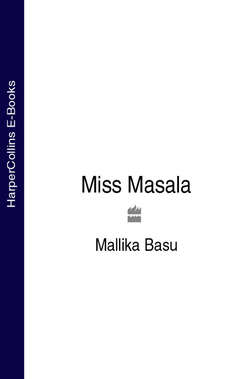Читать книгу Miss Masala - Mallika Basu - Страница 8
ОглавлениеACHIEVING ‘AUNTYDOM’ WAS NEVER GOING TO BE EASY.
Such high standards. So many spices, so little time. No information on what they actually do. Or how best to use them, for that matter. I started my quest with a trip to the nearest aunty, conveniently located in Birmingham – epicentre of the British curry phenomenon.
The door flew open and Aunty launched into high-pitched squawks about how thin I looked. In my family, being thin is considered an even worse fate than left-handedness, singledom or unemployment. More cries of ‘gaunt/tired/malnourished’ were the cue for me to step into the kitchen where Aunty, a senior Indian Diplomatic Officer, had laid out a dazzling four-piece, home-cooked meal.
Aunty lamented the sorry state of the Indian government, the rise of the balti and the problem with young people today. I worked my way through the coconut and raisin dal, chilli pumpkin stir-fry and spicy chicken curry, agreeing and wondering what possessed me to aspire to such dizzying culinary heights.
If Aunty was to be believed, everything was ‘so easy to make’. The dishes, authentic recipes passed down from her great-great-grandmother’s north Kolkata kitchen, took ‘no time at all’. My hopes were fading fast, like the empty space in my rapidly filling stomach.
But I dared not mention this to her. The size-eight-one-who-was-wasting-away would need to be comatose or sick before she was allowed to stop eating. I contemplated faking a fainting spell as she heaped more basmati rice on to my plate.
The next day, we visited a local curry house. Inspired by the delights of the previous night’s authentic Indian meal, I took a fresh, critical look at the fare that had, until now, been my happy respite from three-for-a-fiver microwave meals. I reflected on several interesting things:
1. The word ‘curry’ means ‘sauce’ or ‘gravy’ in India. In the UK, on the other hand, it’s used as a generic term for pretty much all Indian, Pakistani and Bangladeshi food. Not all our dishes are curries – there are bharta, bhuna, tandoori and kadai dishes, and many others besides. In a nod to popular British culture, however, I have used the words ‘curry’ and ‘Indian food’ interchangeably throughout this book.
But don’t get me on to balti, which means ‘bucket’. Fancy dinner out of a bucket? Me neither. Some say balti originated from the Kashmiri province of Baltistan. The truth is that the word was coined by a clever Brummie and has as little to do with cooking as my ceramic hair irons.
2. This creativity extends to restaurant menus. Many of the popular British curry dishes don’t exist in India. Such as phal (mouth-numbingly hot), madras (fluorescent red and gloopy), and chicken tikka masala (no description needed). The perfect greasy end to an alcohol-ridden evening they are. Indian they are not.
Interestingly, chicken tikka masala has had the rare privilege of infiltrating many restaurant menus in India. It is based on a far more delectable, decadent and diet-defying dish, Murgh Makhani (also known as ‘butter chicken’), which is sadly harder to find in the UK.
3. The range of dishes at a standard local curry house is pretty limited. The same cubes of pre-prepared meat are stirred into a set number of curries, depending on what you fancy. Where are the sweet, light Bengali curries? The coconut-filled south Indian dishes? The rich, spicy feasts from Mughal-inspired Hyderabad and Lucknow? And the famous fusion cuisine of the Parsis and Goans? Even the few recognisably Indian dishes on the menu are transformed beyond recognition before they arrive at the table.
MY MOST HATED UK CURRY LINGO
Naan bread
Naan is bread, so this translates as ‘bread bread’. Plain wrong.
Pulao rice
‘Pulao’ means ‘flavoured rice’. I rest my case.
Poppadom
In Hindi, this is ‘papad’, which is conveniently shorter.
IT WAS TIME FOR ME TO SACRIFICE MY LOVE of the local takeaway on the altar of authentic Indian home cooking. Aunty sent me off with a 20-piece dinner set from the local cash and carry. I returned to my ex-council apartment and promptly made my way to the inventively named ‘Indian Spice Shop’ in Euston.
The Indian Spice Shop was as much a part of my teenage years as George Michael and Clearasil. Our family summer holidays in Europe always ended with a few weeks in London, by which time the words schnitzel, strudel and steak frites sent a chill down my spine. I happily played bag carrier to Mother as she stocked up on masalas, pickle and ready-made chappatis for our short-let central London apartment.
But I was alone now. I went round this monument to the art of subcontinental cooking with a rusty basket. Shelves were stacked high with spices, flour, basmati rice, pickles and lentils. I had a list, but it seemed pointless. Where do I start? Where is Mother when I need her?
The owner came to my rescue. To this guy, a first-time masala buyer sticks out like an unaccompanied man in the M&S lingerie department. He advised me to buy the smallest quantities, as you always use less than you think and the flavour of the spices quickly fades.
With that tiny titbit, I started building my collection. The dried spices needed for Indian cooking come in two types – whole and powdered – and are known as masalas. The same word applies to a mix of spices. And it can, confusingly, also refer to a paste of dried spices with fresh ingredients, such as onions, garlic and ginger. First I bought the very basics – the ingredients used in many of the recipes I had bookmarked to try.
